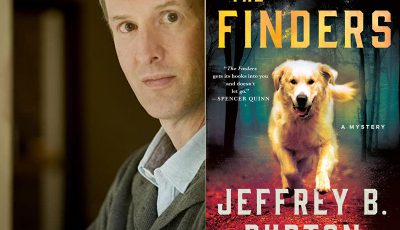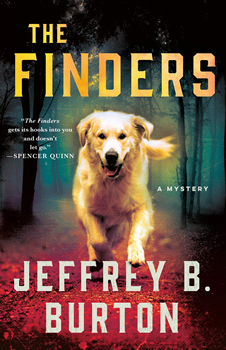

BookTrib Spotlight: Jeffrey B. Burton
A Dog Sniffs Out Bodies—and Killers
Human beings have five million scent receptors. Some breeds of dog have 300 million, which is what makes them such good trackers. For Chicago PD consultant Mason “Mace” Reid, however, he’s never met any dog like the golden retriever named Vira.
In Jeffrey Burton’s THE FINDERS, Reid is a trainer specializing in cadaver dogs, animals with a very specific job—they find dead bodies. Vira, though, does more than that: “It’s like she takes it all in, inhales it or something—disappears for a moment inside herself or somewhere,” he says to policewoman Kippy Gimm, “and then comes back with some kind of …insight…She makes links, she makes relationships…connections—she connects the dots.”
Those dots lead her not just to the bodies, but to the killers, which is an awesome ability—unless it puts you in their crosshairs.
Reid’s had a pretty bad year, highlighted by a broken marriage and the death of his favorite dog, a one-two punch that had put him “on a first-name basis with heartache. Heartache had moved all of his shit into my spare bedroom. Heartache and I were about to restore a 1968 Ford Mustang from scratch. Heartache and I were getting serious about forming a garage band.”
But now the puppy had not only found the latest victim of a serial killer, but had raced into a crowd of gawkers and mauled a young man who turned out not only to be the murderer, but to have another victim imprisoned in his house, barely alive.
All this would seem to be cause for some serious celebration—until more bodies start showing up, their placement getting closer and closer to Mace himself. For it seems that the young man was only an apprentice, with much still to learn. “Killing [is] easy,” muses the man who had become his mentor. “Getting away with homicide [is] the tricky part.”
And the older man had been doing just that for many years. It would be a pleasure to add Reid to the body count.
Fast, twisty, darkly funny, filled with adrenaline and distinctive characters both human and canine, THE FINDERS races to a finish that will leave you breathless.
“I was driving to the Dakota County Judicial Center in Hastings, Minnesota, for jury duty (yes, got selected for an impossibly complex real estate case),” says Burton, “and caught a report on the radio about a nearby Sheriff’s Department bringing in cadaver dogs to hunt for someone who’d gone missing. While shuffling through courthouse security, I thought how there’d been stories on bomb and drug-sniffing dogs, but a story about cadaver dogs—more accurately, human remains detection (HRD) dogs—might provide an interesting twist.
“During my time as a juror, they passed out yellow legal pads for us to jot down notes and questions as the trial progressed. During breaks, I jotted story ideas on the notepad’s back page regarding plot structure and characters as well as what would draw a dog handler and his prize HRD dog into a murder mystery. So imagine my surprise when the trial ended and the judge came into the jury room, discussed our verdict, and informed us the bailiff would soon be in to collect our legal pads. I’d scribbled 20-something bullet points on the pad’s last page and feared I’d forget many of them on the drive home.
“I tore the last page from my legal pad, bumbled about awkwardly, dropping paperwork, pen, and empty coffee cup onto the floor, bent down, jammed the errant page into my briefcase, and sat back up with moments to spare before the bailiff began shaking his archive box in front of me as though soliciting Halloween candy.
“Originally, these notes served as a roadmap for a short story, but the story was skeletal-thin and I realized it needed to be a novella. However, once I hit 40,000 words, I knew I had a full-blown novel on my hands.”
This was not dissimilar to the way he’d worked before: “I bumped into an author recently who told me that he uses speech-to-text software in order to speak the entire first draft of his novel onto paper. That’s such a foreign process for me to digest that he might as well have told me he pees his first draft into the side of a snowbank. I need the symbiotic relationship of putting pen to paper just to get the juices flowing.
“I’ll jot down a story idea and loose plot outline, and then let it ferment. Maybe a month later, if by then it doesn’t sound too terribly absurd, I’ll begin writing chapters on a yellow legal pad. Then I’ll edit like crazy as I enter those chapters into Word so that by then it’s in a second draft format. I keep doing that until I hit about 75,000 words, and then the hardcore editing begins.”
For this book, Burton knew he had to do more research into HRD dogs.
“I’m a research geek. Thank God for Google. I’ll read about a topic for hours, but wind up with a paragraph or even just a sentence or two. It’s a delicate balance getting the feel and facts right in order to suspend disbelief versus overloading or boring the reader.
“While researching the history of search and rescue dogs, one of the most interesting things I discovered along the way was that casualty dogs (also known as mercy dogs or Red Cross dogs, sanitary hounds or sanitatshunde) were originally trained by the German armies of the 1800s to hunt for the wounded and the dying, and were utilized by both sides during World War I. Sometimes these dogs carried medical supplies in saddlebags, which helped injured soldiers tend to themselves until they could receive medical care from a doctor or battlefield medic.
“Casualty dogs could distinguish between the dead and unconscious. If a soldier was dead, the dog would move on; if the soldier was injured, the dog would return to friendly lines for help; but if the soldier was dying, the dog would remain with him in order to offer comfort. That is, if a wounded warrior was too far gone, the dog would stay with him as he passed away, accompanying him so he wouldn’t feel left alone. There’s something terribly bittersweet and wonderful in that.”
Burton also had some help closer to home. “My wife and I are dog people, and have rescued and adopted several of our furry friends. I wish I was an expert dog trainer like Mace Reid, but Milo the beagle continues to jump up on folks and squeeze under the sofa at the first sound of thunder. And Lucy the Pomeranian thinks she can go Jack Reacher on every dog we pass on our daily walk.”
THE FINDERS is actually Burton’s sixth book, after a horror story collection, a mystery co-written with his father, and three books featuring an FBI special agent named Drew Cady.
“I started out writing in various genres of short stories, but quickly found the horror stories were the ones that sold. However, when it comes to full-length novels, I love reading and writing mysteries and thrillers. Every author is a bookworm at heart, and the worst thing about being an author is that it cuts into my reading for pleasure time. I barely make much headway on the stack of books piling up on my bedside table.”
He cites in particular Michael Connelly, Barry Eisler, Gillian Flynn, Harlan Coben, John Sandford, Lee Child, John Connolly, and Robert Crais.
The stories behind the some of the six previous books, however, might be as interesting as the books themselves.
“I may be the only author to have three books in a series published by three different publishers.
“The Chessman (a serial killer in hot pursuit of his own copycat) was published by MacAdam/Cage, who’d had great success with The Time Traveler’s Wife, but, sadly, MacAdam/Cage’s president passed away in 2013 and MacAdam/Cage spiraled into bankruptcy in 2014. Instead of royalty checks, I got listed in a bankruptcy proceeding.
“My second Agent Drew Cady mystery, The Lynchpin (serial killers and spies) was published by MP Publishing. Editors from MacAdam/Cage jumped ship to MP Publishing and the manuscript had been passed along. They called, buttered me up, and swore MP was an up-and-comer with a thriving San Francisco office chock full of editors and publicists. Since MP’s maiden voyage had been a collection of essays by the likes of John Grisham and Pat Conroy, of course I signed. Three months later, MP Publishing’s entire San Fran office quit in unison and MP never recovered from that implosion. My book limped along with their two remaining employees on the Isle of Man, both of whom also quit before the novel came out.
“But third time’s a charm and my last Agent Drew Cady mystery, The Eulogist (a United States Senator is murdered with his eulogy left at the scene), found a great home at The Permanent Press.
“In terms of my early endeavors—a collection of short stories (Shadow Play), a mystery novel I’d written with my father (Sleuth Slayer)—I was a lunkhead. I’d found a publisher listed in Novel & Short Story Writer’s Market and idiot me assumed it had therefore been vetted by Writer’s Market. Instead, the publisher was the kind they warn against—minimal to no editing, no real marketing or promotion, and the guy got snappish if he caught me pushing readers to Amazon instead of his website.
“Sleuth Slayer was about mystery writers being bumped off, so imagine my spike in blood pressure when the cover art arrives and it’s the torso of a teenage boy who’s holding out $25 as though paying for a tank of gas. It was as though the publisher had reached into a bag of cost-free clip art and randomly yanked out an image. Even though I made him select a different jpeg, it was at that point I knew I’d been had. Ultimately, the St. Paul Pioneer Press gave Sleuth Slayer a good review but also pointed out several typos—sweet, everyone in Minnesota got to know I’m a dipwad. I’m still living that one down.”
THE FINDERS will definitely help him in that endeavor, and the next book in the series, The Keepers, is already in the works. Anyone who’s finished Mace’s first adventure will undoubtedly agree: Reid, Gimm, and Vira are keepers themselves.
*****
Neil Nyren retired at the end of 2017 as the executive VP, associate publisher and editor in chief of G. P. Putnam’s Sons. He is the winner of the 2017 Ellery Queen Award from the Mystery Writers of America. Among his authors of crime and suspense were Clive Cussler, Ken Follett, C. J. Box, John Sandford, Robert Crais, Jack Higgins, W. E. B. Griffin, Frederick Forsyth, Randy Wayne White, Alex Berenson, Ace Atkins, and Carol O’Connell. He also worked with such writers as Tom Clancy, Patricia Cornwell, Daniel Silva, Martha Grimes, Ed McBain, Carl Hiaasen, and Jonathan Kellerman.
He is currently writing a monthly publishing column for the MWA newsletter The Third Degree, as well as a regular ITW-sponsored series on debut thriller authors for BookTrib.com, and is an editor at large for CrimeReads.
This column originally ran on Booktrib, where writers and readers meet:
- LAST GIRL MISSING with K.L. Murphy - July 25, 2024
- CHILD OF DUST with Yigal Zur - July 25, 2024
- THE RAVENWOOD CONSPIRACY with Michael Siverling - July 19, 2024




